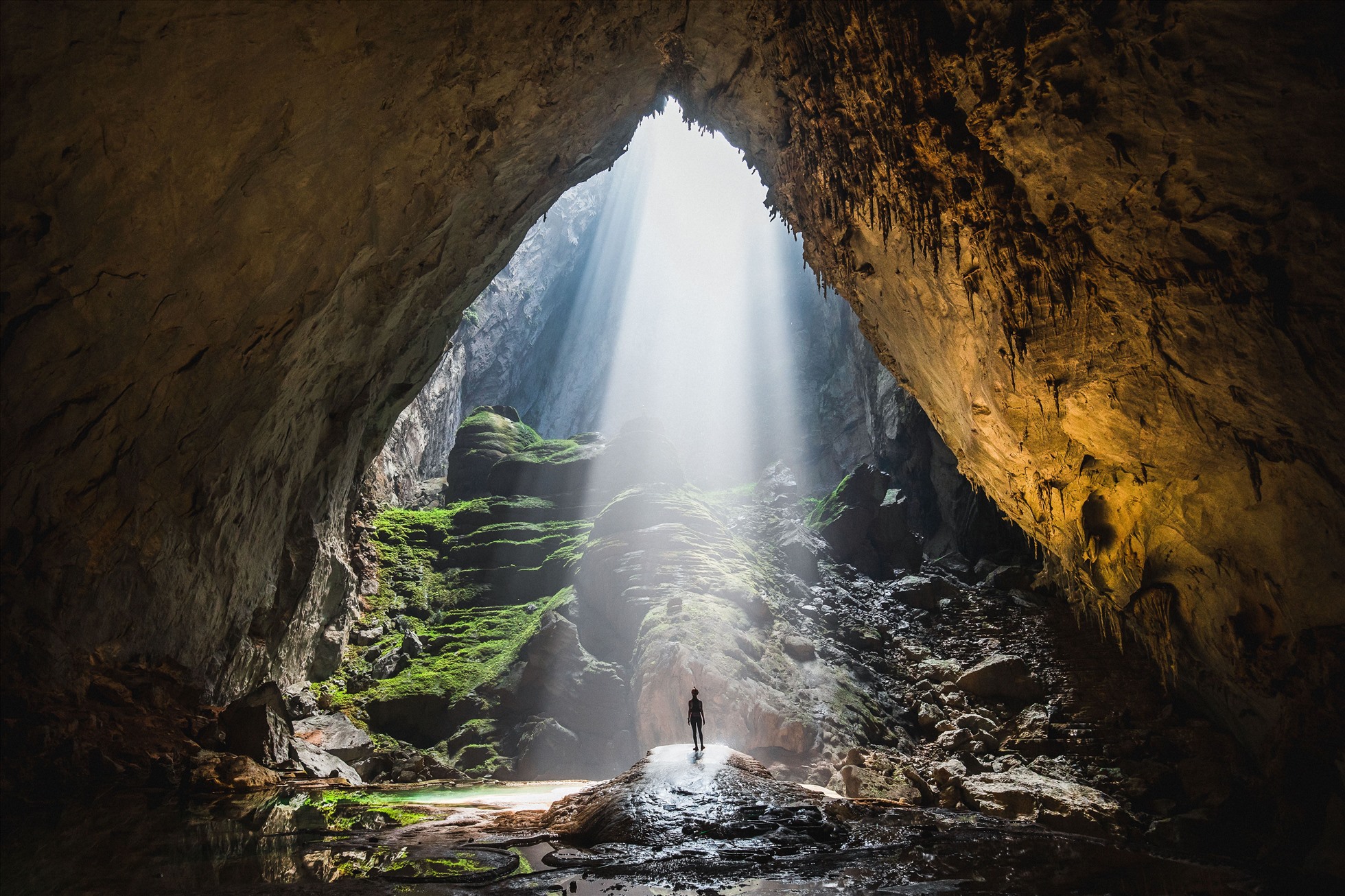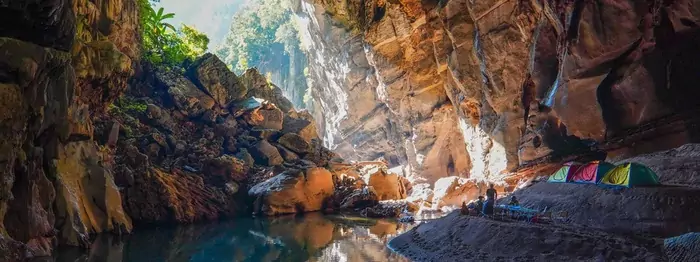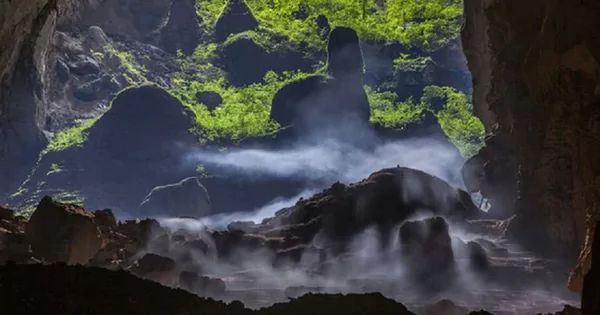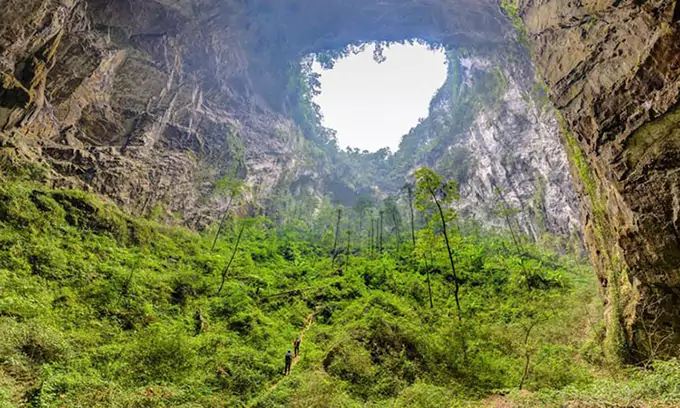Son Doong Cave, located in Phong Nha – Ke Bang National Park, Quang Binh Province, Vietnam, is recognized as the largest natural cave in the world. With its majestic beauty and unique features, this cave not only draws the attention of explorers and scientists but has also become a dream destination for many travelers who love exploring unspoiled nature. Let’s explore the details of this world’s largest cave with FoodVietnamese.com.
Exploring Son Doong Cave
History of Discovery

Son Doong Cave was discovered in 1991 when Ho Khanh, a local resident, stumbled upon it while seeking shelter from the rain at the cave entrance. It wasn’t until 2006, when an expedition team from the British Royal Cave Association came to survey the area, that Ho Khanh informed them. It was quite challenging for him to relocate the cave entrance, which is deep within the dense jungle, with rugged terrain, far from major roads, and undetectable on Google Earth. He is also the one who named the cave.
After discovering and exploring Son Doong Cave on April 5, 2009, the British Royal Expedition team shocked the world. The discovery of Son Doong Cave has been likened to finding the Everest of the underground world. The British Royal Expedition team honored Ho Khanh by allowing him to name the cave. Once announced, Son Doong Cave captured the attention of major global media outlets such as the Daily Mail, Telegraph, The Sun, Breitbart, and Newser. Stories and images of the exploration journey spread widely, helping to establish Son Doong as a symbol of pioneering and magnificent exploration.
Son Doong Cave was formed approximately 2-5 million years ago when river water eroded the limestone beneath a fault line. The water carved out a massive tunnel beneath the mountains. With its unique features and exceptional scale, Son Doong Cave has elevated the Phong Nha – Ke Bang cave system to a world-renowned cave kingdom. Geologists worldwide also recognize Son Doong as the most magnificent cave in the world.
Geographical Location
Son Doong Cave is located in Tan Trach Commune, Bo Trach District, Quang Binh Province, Vietnam. The geographical coordinates of Son Doong Cave are 17°27’25.88″ N, 106°17’15.36″ E. Situated deep within Phong Nha – Ke Bang National Park, it is part of an underground system connected with over 150 other caves in Vietnam near the border with Laos. This location contributes to Son Doong’s mystery and minimal human impact until its discovery.
With a length of nearly 9 km, a width of up to 150 m, a maximum height of 200 m, and a volume of up to 38.5 million cubic meters, Son Doong Cave has surpassed Deer Cave in Malaysia to become the largest natural cave in the world. This discovery has altered the global cave geography map and brought international recognition to Vietnam’s tourism potential and natural value.
It must be said that Son Doong is not only a natural wonder of Vietnam but also a treasure of the world. Its location, surrounded by dense forests and limestone mountains, creates an independent and rich ecosystem. This adds to the cave’s mystery and allure, making each expedition there feel like a never-ending journey of new exploration.
Size and Structure
With a length of nearly 9 km and a volume of up to 38.5 million cubic meters, Son Doong Cave is considered the largest natural cave in the world. These numbers are truly impressive, especially when compared to other famous caves. For example, Deer Cave in Malaysia, previously regarded as the largest natural cave, has a volume of only about 8 million cubic meters, making Son Doong nearly five times larger.
Son Doong Cave features unique and complex structures, including:
- Giant Stalagmites: Over 80 meters high, these formations result from mineral precipitation over millions of years, creating unique and magnificent shapes.
- Hope and Vision Corridors: This is one of the largest areas in Son Doong Cave, with a height of up to 200 meters and a width of over 150 meters, large enough for a 40-story building or a Boeing 747 to pass through.
- Underground River: An underground river flows inside Son Doong Cave, formed from water flowing from En Cave and Khe Rang Cave, creating a mysterious stream that explorers have yet to fully uncover.
- Sinkholes: Son Doong has two large sinkholes – Sinkhole 1 (Watch out for Dinosaurs) and Sinkhole 2 (Garden of Edam). These sinkholes were created by the collapse of the cave ceiling, allowing sunlight to enter and support the development of the ecosystem inside the cave.
- Fossil Corridor: Located next to the underground river, 40 meters below the campsite, with many coral fossils hundreds of millions of years old.
- Cave Pearls: Formed from water droplets falling from the cave ceiling into pools, these cave pearls range in size from a pea to a baseball.
These unique features not only make Son Doong Cave outstanding and impressive but also create a distinct and complex ecosystem. Exploring and studying Son Doong helps us better understand the Earth’s geological history and processes.
Unique Ecosystem

The ecosystem within Son Doong Cave is an incredibly rich and diverse underground world, existing and thriving under harsh conditions. There are species that can only be found here, most of which have adapted to the dark and damp environment of the cave. These factors not only pique the curiosity of scientists but also captivate those passionate about exploration.
In Son Doong Cave, explorers have observed many animal species such as monkeys, snakes, squirrels, rats, bats, and birds. Notably, the exploration team discovered seven new species, including:
- Fish
- Spiders
- Scorpions
- Shrimp
- Crickets
- Beetles
- Plankton
All of these newly discovered species are completely white and eyeless, a consequence of existing in complete darkness. This demonstrates the strong adaptation and transformation of species to survive in an environment without sunlight.
Additionally, unique features like the ‘Great Wall of Vietnam,’ a 90-meter high calcite wall located at the end of the cave and also where the ceiling reaches its highest point of about 200 meters, further enhance the uniqueness of the ecosystem inside the cave.
The Fossil Corridor, with coral fossils from 300 million years ago, serves as evidence of the cave’s rich and valuable history. The sinkholes create small forests inside the cave, such as the first sinkhole – ‘Watch out for Dinosaurs’ and the second sinkhole – ‘Garden of Edam,’ where sunlight has enabled plants and microorganisms to thrive.
This unique ecosystem has attracted the attention of many scientists and researchers, not only to discover new things but also to better understand how species adapt and evolve in harsh environments.
Outstanding Features

Son Doong Cave is not only the largest cave in the world but also stands out for its incredibly unique features. With a length of nearly 9 km and a volume of up to 38.5 million cubic meters, the massive size of Son Doong makes it a one-of-a-kind natural wonder.
One of the standout features of Son Doong is its impressive system of stalactites and rock formations. The cave contains many oddly shaped stalactites, and notably, an area with a primeval forest growing inside the cave. The appearance of the ‘Garden of Eden,’ where a portion of Son Doong’s roof collapsed years ago, has allowed light to flood in, enabling lush vegetation to thrive. The Garden of Eden is a vast area with abundant plant life, expansive waters, and surrounded by clusters of forest trees and various types of vegetation, contributing to a diverse tropical ecosystem.
Another remarkable feature is the presence of cave pearls, with rare pearls formed over thousands of years. This is a colossal calcite wall approximately 70 meters high, dubbed the ‘Great Wall of Vietnam.’
Moreover, Son Doong also has an underground river system and several sinkholes like Sinkhole 1 (Watch out for Dinosaurs) and Sinkhole 2 (Garden of Edam), creating incredibly impressive and unique sightseeing spots. These sinkholes create majestic scenes, reminiscent of mythical paintings of an underground world existing parallel to life on the surface.
These characteristics have made Son Doong a famous place not only for its size but also for its structural and ecological diversity and richness. This not only captivates explorers but also contributes to its strong attraction for tourists from around the world.
Son Doong Cave Tourism

Exploring Son Doong Cave is not just an expedition but a journey through challenges to discover the wonders that nature has bestowed. To visit Son Doong Cave, tourists must undertake a 4-day, 3-night exploration journey that involves many physical and health challenges. Only Oxalis Company is authorized to organize tours to Son Doong Cave, with a maximum of 10 guests per group.
The itinerary for visiting Son Doong includes various activities:
- Trekking through primeval forests and streams
- Swimming and crossing underground rivers and sinkholes
- Camping overnight inside the cave
- Exploring special areas such as the Garden of Eden, the Great Wall of Vietnam, and the Fossil Corridor
Some important points to note when joining a Son Doong tour:
- Health: Tourists need to be well-prepared in terms of health and fitness. Before joining the tour, a health certificate from a doctor confirming fitness is required.
- Equipment: Tourists should bring basic equipment such as warm clothing, hiking boots, flashlights, and other necessary items.
- Timing: The best time to explore Son Doong Cave is from late February to April, when the weather is cool and ideal for trekking.
Exploring Son Doong Cave is not just a trip but a true adventure. From primeval forests and underground rivers to massive sinkholes and majestic stalactites, everything creates a stunning and unique picture. Every step in this journey unveils new enchanting landscapes, like stepping into a different world that has never been explored.
Preservation of Son Doong Cave

The preservation of Son Doong Cave is an extremely important issue to maintain the balance between tourism development and the protection of the natural environment. Son Doong Cave is located within Phong Nha – Ke Bang National Park, an area recognized by UNESCO as a World Natural Heritage Site. Protecting Son Doong, as well as the entire surrounding ecosystem, is a top priority.
Several strict measures have been implemented to protect Son Doong Cave:
- Each year, a maximum of 1,000 visitors are allowed, with tours exclusively organized by Oxalis Adventure Tours.
- Each group is limited to a maximum of 10 guests, accompanied by a team of guides, safety personnel, cooks, and porters.
- All equipment, supplies, and waste must be removed from the cave after each tour.
- Tourism activities must strictly adhere to environmental protection and safety standards.
Additionally, scientists continue to research Son Doong Cave and its internal ecosystem to better understand the organisms living in dark and low-oxygen conditions. Conservation efforts extend beyond cave protection to include scientific research programs, community education, and the development of sustainable tourism strategies.
The main concern is to maintain the balance between tourism development and natural conservation. This not only helps monitor and protect Son Doong but also ensures that this wonder is preserved and safeguarded for future generations. Issues such as climate change, environmental pollution, and human interference are closely monitored to provide timely and effective solutions.
Son Doong Cave in Culture
Local Legends and Culture
Son Doong Cave is not only a natural wonder but also holds many legends and cultural values for the local people. According to local legends, Son Doong Cave is believed to be the dwelling place of deities. They believe that this cave is another world, a mysterious and sacred realm. The locals often refer to Son Doong Cave as the ‘cave of the gods,’ and they hold this place in high reverence.

In the culture of the surrounding people, Son Doong Cave is also considered a symbol of grandeur and natural beauty. This cave is seen as a masterpiece of nature, a marvel that humans cannot create. As such, Son Doong Cave has become a source of inspiration for art, literature, and other cultural activities of the local people.
The exploration and announcement of Son Doong Cave have attracted many tourists from both within and outside the country, contributing to promoting Vietnam’s tourism image to the world. This has also created additional economic opportunities and jobs for the local people. Cultural festivals, art programs, and community activities revolving around the theme of Son Doong are increasingly developing, enriching the cultural life of the people.
Son Doong Cave is not just a natural wonder but also an important part of the culture and legends of the local people. It plays a significant role in the tourism and economic development of the area, while also connecting culture and nature in a very special and profound way.
Son Doong Cave in Art
Son Doong Cave, with its majestic and mysterious beauty, has become an endless source of inspiration for many artists and works of art. In painting, oil paintings, lacquer paintings, and watercolor paintings capture the impressive scenes of Son Doong Cave, from the gigantic stalactites and dolines covered with forests to the mysterious underground rivers. Artists have used vibrant colors and creative techniques to convey the enchanting beauty of this cave.
In music, many Vietnamese musicians have composed songs praising the beauty of Son Doong Cave, ranging from lyrical melodies to folk-inspired tunes. These songs not only honor Son Doong but also evoke love and appreciation for nature. The cave has become a symbol of national pride, a theme frequently explored in Vietnamese music and cultural arts.
In literature, authors have created numerous works inspired by Son Doong Cave, from short stories and novels to poetry. These works vividly depict the cave’s mysterious beauty and power while conveying messages about environmental protection and respect for nature. For example, some novels are set in Son Doong Cave, taking readers on a journey of exploration, delving into geological history as well as the mysterious creatures inside the cave. These inspiring writings have sparked a movement of love for nature, exploration, and rediscovery of the cultural and historical values that Son Doong offers.
In the field of photography, Son Doong is also a subject sought after by many photographers. Photographs taken here always exude a pristine, majestic, and mysterious beauty, captivating many viewers. Renowned photographers have spent considerable time and effort capturing breathtaking moments at Son Doong, thereby introducing unique perspectives of this wonder to the art-loving community worldwide.
International Importance

Son Doong Cave is not only important on a national level but also has significant influence internationally. Initially, when the cave was discovered, it created a frenzy among scientists and explorers. Son Doong is considered a ‘holy land’ for nature lovers and adventure enthusiasts. With a length of nearly 9 km, a width of up to 150 m, a maximum height of 200 m, and a volume of 38.5 million cubic meters, Son Doong has amazed and impressed people with its enormous size and rich ecosystem.
Located in Phong Nha-Ke Bang National Park, a UNESCO-recognized World Natural Heritage site, Son Doong holds even greater importance. UNESCO’s recognition not only affirms the natural value of Son Doong but also helps protect and solemnly preserve this wonder. This is significant not only for environmental protection but also greatly contributes to sustainable tourism development, providing long-term economic benefits for the region and the nation.
Son Doong is an attractive destination for explorers from around the world. Expeditions and surveys here have yielded valuable information, not only about geology but also about biology and the environment. Discoveries in this cave have helped expand understanding of underground ecosystems and contributed valuable information to the scientific community.
Beyond being a destination for adventure tourism and exploration, Son Doong also inspires art and culture. This is reflected in countless works of art, photography, films, and scientific studies. The activities linking culture and tourism here have not only raised community awareness about environmental protection but also created a sustainable foundation for socio-economic development.
Son Doong Cave, with its unique characteristics and majestic presence, is not only one of the largest natural wonders in the world but also a symbol of nature’s grandeur and power. From its fascinating exploration history to its unique geographical location, enormous size, complex structure, and rich ecosystem, Son Doong has captured the interest of scientists, explorers, and tourists from all over the world.
Beyond its natural value, Son Doong is deeply connected with local culture and history, enriching Vietnamese culture through stories, legends, and works of art. These elements not only honor Son Doong but also reflect the appreciation and protection of the precious natural values we are fortunate to inherit.
The preservation of Son Doong has been and continues to be carried out strictly and closely, aiming to maintain a balance between sustainable tourism development and environmental protection. These efforts have helped Son Doong become not only a famous tourist destination but also a national pride and a significant contributor to the protection and study of nature worldwide.
Son Doong Cave will forever be a vibrant symbol of Vietnam’s nature, a dream destination for anyone who loves nature, exploration, and life. Let us work together to protect and preserve this natural wonder for future generations, so they too can admire, explore, and take pride in the great heritage we have.
